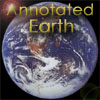|
Q: What's location-aware?
A: Location-aware technology allows a computer-based device to figure
out what's around it. Usually "around" translates to "what's directly
around me, right now". As you move, the various things (buildings,
places, et al) change - and location-aware technology allows computers to know
about that change. You can think of any given area (say, a town) to be a
mass of location information, or annotations. Buildings, streets,
restaurants, houses, stores, interesting art work, a spot to meet your friends
every Monday, just about anything. AnnotatedEarth enables any
computer device (laptops, cell phones, and PDA's among a few) to understand
where you are and what's around you. Location-aware is sometimes also
called "Context-aware".
Q: What do I need to use the location-aware technology?
A: To full access this technology, you need a computer capably of running
AnnotatedEarth-enabled applications, a wireless connection to the internet, and
a device to determine your current latitude and longitude (generally some type
of GPS device, even though it's possible to get that information outside of
traditional satellite-based GPS systems). It is possible for applications
to be written that don't require a constant connection to the internet, but
none have been written at this time.
Q: That's a lot of requirements...
A: AnnotatedEarth was created to take advantage of the convergence of
widely available WiFi, mobile computing, and highly accurate
GPS information. While these requirements are currently limiting,
this system was developed with the belief that these technologies will become
more available over the next several years, allowing for a wide audience
that can meet these requirements.
Q: What does the website provide? What's the
difference between it and the client applications?
A: The web site is actually just another client to the AnnotatedEarth
infrastructure. It was initially developed to manage location information
(coordinates, or "waypoints") that were being used for location-aware
clients. It has grown to be a generic repository of GPS waypoints, in
addition to managing location-aware information.
The non-web clients currently available actually
implement the location-aware part of the technology. This includes both
detecting what's aroudn
Q: Where's the maps? Directions to places?
A: AnnotatedEarth is very focused on the question "What's immediately around
me". This generally translates to something within view; 20 feet, 50
feet, 100 feet, etc. While mapping can be provided, AnnotatedEarth, as a
system, doesn't directly provide for
map creation or directions (all the clients allow you to pop a web browser
window with a mp). We are currently looking for an existing mapping
application to integrate to the AnnotatedEarth technology. By using the
AnnotatedEarth infrastructure, third-party developers can add location-aware
abilities to their software.
Q: How accurate is this location-aware stuff,
anyway?
A: Well, that depends on a few
things. The GPS unit you're using, how good a lock you have on the
satellites, and how many you lock on to. Generally the best it will do is
15 meters. If you have a WAAS-enabled receiver, that goes down to 3
meters. If you're using a cell phone or LAN node-based location
information, that can get better (or worse).
Q: Who can develop AnnotatedEarth-aware applications?
A: Anyone! The information to interface to the AnnotatedEarth location
service is free for anyone to use. It specifically uses HTTP as input (like
your web browser does; a url), and text-based XML documents as output.
Look here for more information. Want to
see what AE sends back on a request? Look
here
|

